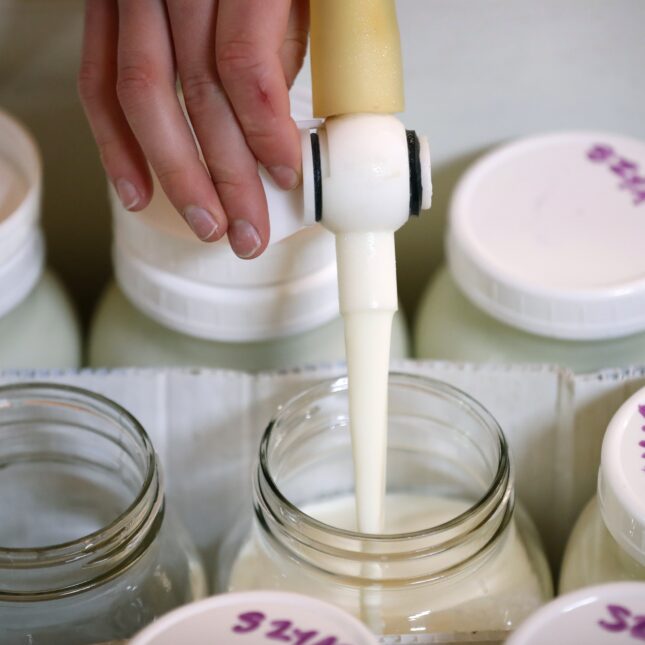
Bird flu snapshot: This is the latest installment in a series of regular updates on H5N1 avian flu that STAT is publishing on Monday mornings. To read future updates, you can also subscribe to STAT’s Morning Rounds newsletter.
Last week, following an unusually udder pun-laden discussion, lawmakers in Delaware voted to become the latest state to legalize the sale of raw milk. Not part of the discussion was the fact that an ongoing outbreak of H5N1 bird flu in U.S. dairy cattle has scientists increasingly concerned that the virus could be transmitted to humans through raw milk.
While there have not yet been any confirmed human cases of bird flu transmission as a result of raw milk consumption, with the number of affected herds continuing to rise — the figure hit 141 in 12 states at the end of last week — public health officials worry it’s just a matter of time. (The USDA’s count was 140 on Friday, which did not include the latest detection in Iowa.)
Results of a recently released study conducted by the Food and Drug Administration and U.S. Department of Agriculture show that commercial pasteurization techniques effectively reduce virus in milk to undetectable levels. But the study — which was released as a preprint, meaning it has not yet been peer-reviewed — also found an alarming amount of infectious virus is getting off of farms in contaminated milk.
Over two weeks in late April, officials from four states with infected herds collected 275 raw milk samples from bulk tanks — large storage tanks used to cool and store milk until it can be picked up and pooled for processing. Scientists from the FDA and the USDA were able to grow live virus from 14% of raw milk samples.
Don Prater, the FDA’s acting director of the Center for Food Safety and Applied Nutrition, told journalists Tuesday that the study’s results “provide broad assurance that pasteurized milk and dairy products made from pasteurized milk are safe.”
But they also underline shortfalls in the dairy industry’s ability to identify contaminated milk and divert it from the food supply. Those lapses are not necessarily due to negligence; researchers suspect that cows may be able to shed virus into milk before showing clinical signs of illness, and studies evaluating this possibility are currently underway.
Raw milk also remains a concern because people who are exposed to it on the job continue to fall ill.
In Colorado — where one-quarter of the state’s dairy herds have been impacted by H5N1— state health authorities announced Wednesday the nation’s fourth human case of bird flu infection linked to the current outbreak. In a statement, health officials said the infected individual is an adult male farmworker who had mild symptoms, reporting only conjunctivitis, or pink eye, and has since recovered.
Three additional farmworkers, in Texas and Michigan, are known to have developed mild cases of H5N1, presumably from close contact with cows.
The Centers for Disease Control and Prevention said this latest infection doesn’t change the agency’s assessment that H5N1 bird flu is a low health risk for the general public. But the CDC announced last week that it is preparing for the possibility that the virus evolves to more easily spread to and between humans. As part of that effort, the agency is taking steps to ramp up the nation’s capacity to detect bird flu in people, including working with commercial labs to produce more H5-specific tests.
The move was hailed by many as a welcome development, given how the CDC’s testing failures at the outset of the Covid-19 pandemic allowed the coronavirus to spread undetected. Others believe the agency is repeating many of the same mistakes. Rick Bright, the former head of the Rockefeller Foundation’s short-lived Pandemic Prevention Institute, and now a consultant in the pandemic preparedness sphere, said on X that there needs to be more emphasis on developing rapid, at-home tests for H5N1, which will be more useful in the event of an influenza pandemic.
On Tuesday, the Biomedical Advanced Research and Development Authority — the federal agency Bright helmed from 2016 through 2020 — announced plans to support the development of messenger RNA-based pandemic influenza vaccines. BARDA awarded a $176 million contract to Moderna, the company that produced one of the first Covid-19 vaccines.
In addition to the deal with Moderna, which is expected to begin a Phase 3 clinical trial of its pandemic influenza vaccine next year, the U.S. government already has vaccine contracts and stockpiles of H5 vaccines made using other platforms by other manufacturers, including CSL Seqirus and Sanofi.
Dawn O’Connell, assistant secretary for preparedness and response at the Department for Health and Human Services, told reporters last week that nearly 5 million doses of H5 vaccine are being moved out of bulk storage and put into vials, with the first doses expected to roll off the finishing line in mid-July.
At this time, federal health officials are not recommending H5N1 vaccination for any segment of the U.S. population. In Finland, however, the government last week began offering shots to people at risk of exposure — the first country to take such action. Although the Scandinavian nation has not recorded any H5N1 infections in humans, there have been outbreaks at fur farms among mink and foxes.
Finland has acquired 20,000 doses of an H5 vaccine manufactured by CSL Seqirus — enough to vaccinate 10,000 people, with priority going to fur farm workers, poultry farmers, veterinarians, and scientists who study the virus. According to a public database, 15 shots have been administered so far, although Anniina Virkku, a medical specialist with the Finnish Institute for Health and Welfare, told STAT in an email that due to delays in data transmission, “the actual number of doses administered might be higher.”
To submit a correction request, please visit our Contact Us page.











STAT encourages you to share your voice. We welcome your commentary, criticism, and expertise on our subscriber-only platform, STAT+ Connect